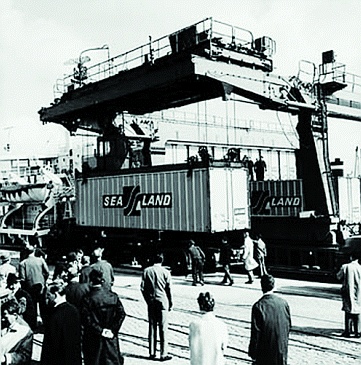Shipowners were more than a little skeptical about McLean's idea. This prompted him to become a shipowner himself and he appropriately named his company Sea-Land Inc. At the end of the 1990s, McLean sold his company to the Maersk shipping company, but his company name lives on in the name Maersk Sealand.
In the literature, the "Ideal X" is mentioned as the first container freighter. This ship left Newark on 26th April 1956 carrying fifty-eight containers, which it transported to Houston. The first ship designed to carry only containers is the "Maxton", a converted tanker, which could carry sixty containers as deck cargo. That was in 1956.
Another decade passed before the first container ship moored in Europe. The first container on German soil was set down by the "Fairland" at Bremer Überseehafen on 6th May 1966. The first containers used by SeaLand in Northern Europe were 35' ASA containers, i.e. they were constructed to American standards. In other regions, 27' ASA containers and other ASA dimensions were often used. Shipowners in Europe and Japan quickly recognized the advantages of the container and also invested in the new transport technology.
Since American standards could only be applied with difficulty to conditions in Europe and other countries, an agreement was eventually reached with the Americans after painstaking negotiations. The resulting ISO standards provided for lengths of 10', 20', 30' and 40'. The width was fixed at 8' and the height at 8' and 8' 6". For land transport within Europe, agreement was reached on a 2.50 m wide inland container, which is mainly used in combined road/rail transport operations.
The majority of containers used worldwide today comply with the ISO standard, with 20'- and 40'-long containers predominating. For some years, the ISO standard has come repeatedly under pressure. As stowage factors increase for most goods, many forwarders want longer, wider and higher containers, preferably all at once. Some shipowners have given in to the pressure and containers of dimensions larger than provided for by the ISO standard are now encountered distinctly more frequently. "Jumbo" containers of 45' and 48' in length, widths of 8'6" (2.60 m) and heights of 9'6" (2.90 m) have been in existence for some years. Efforts to build even larger containers, e.g. 24' (7.43 m) and 49' (14.40 m) boxes 2.60 m wide and 2.90 m high, are mostly confined to the USA. Even 53' long containers have been approved for use for some time throughout the USA, while some states will even allow 57'. In Europe and on other continents, narrower roads are a limiting factor. Developing countries are understandably against changing the standards. More details are given in the section entitled "Container dimensions and weights".
